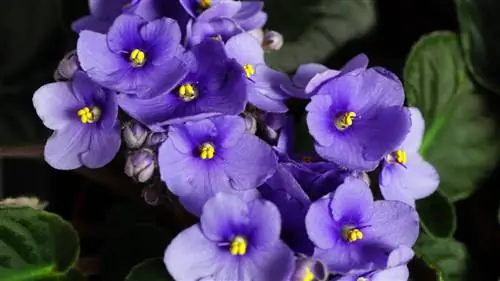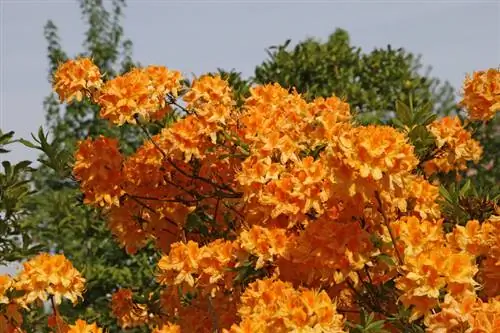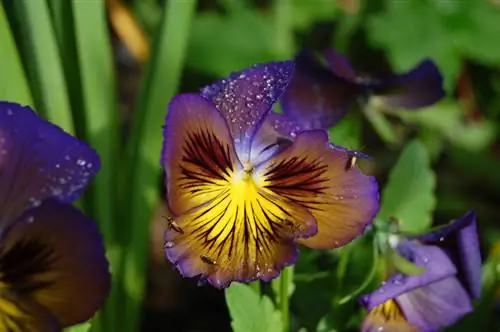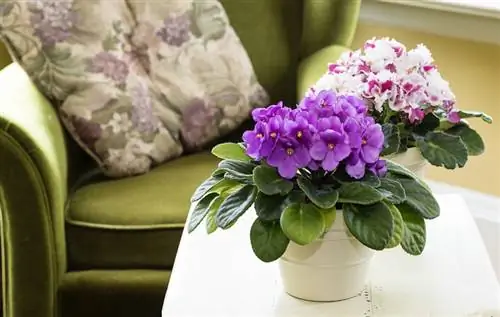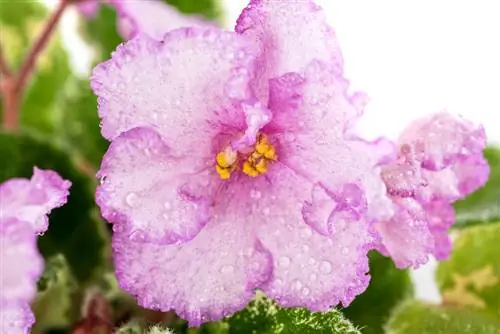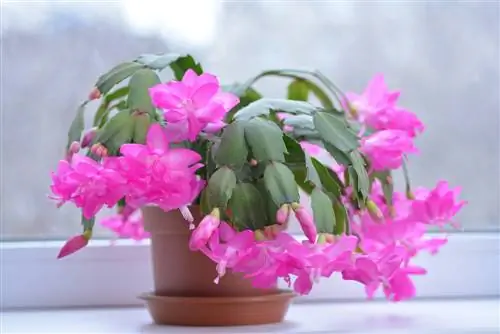- Author admin [email protected].
- Public 2023-12-25 17:45.
- Last modified 2025-01-23 11:22.
African violets spread a cheerful floral atmosphere on the windowsill. The cute houseplants with densely packed flowers and evergreen foliage are a little tricky to care for. If you still have questions about cultivation, you can get a practical answer here.
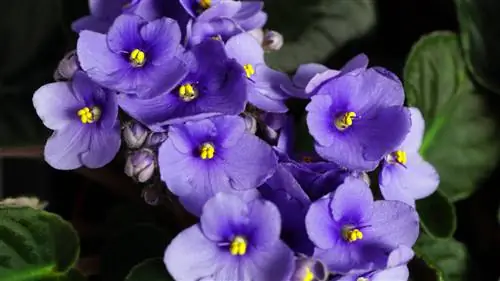
How do you properly care for an African violet?
African violets thrive in partially shaded locations, temperatures of 20-25 degrees, humidity of over 60% and regular watering and fertilizing. They prefer slightly acidic, loose soil and need a winter break at 15-16 degrees for optimal flowering.
Care tips
In order for the lovely African violet to produce its concentrated flowers, a careful care program is required. Keep in mind that the plant is native to the tropical climate of East Africa, with a warm, humid climate all year round. How to meet the requirements:
- Keep the substrate constantly slightly moist
- If the soil dries, water it with soft, lukewarm water
- Fertilize liquidly every 2 weeks from March to September or all year round
- Alternatively, administer a slow-release fertilizer according to the dosage instructions
- Repotting in spring when the flower pot is completely rooted
- Do not cut off withered plant parts, but tear them off
If you allow a Saintpaulia to rest during the winter, the houseplant will move to a bright, cool room in November. At temperatures around 15 degrees Celsius, only water enough to ensure that the substrate does not dry out. The African violet does not receive any fertilizer during this time.read more
Which location is suitable?
The African violet will spoil you with a tireless gala of flowers if the following site conditions are guaranteed:
- Partially shaded spot on the west, east or north window without direct sunlight
- Artificial lighting does not affect growth and flowering
- Warm temperatures between 20 and 25 degrees Celsius without cold drafts
- Tropically high humidity of more than 60 percent
The African violet finds a warm, humid microclimate in the bathroom, the indoor pool or on the windowsill in the spa. In the living room, humidifiers (€31.00 on Amazon), an indoor fountain or bowls filled with water serve their purpose. If you fill the coaster with pebbles and water, the tropical beauty is constantly surrounded by moist air.read more
The correct planting distance
If you combine different varieties of the African violet or combine the flower with other plants in the pot, the planting distance should correspond to half the growth width. If planted at a distance that is too loose, Saintpaulia will not develop the typical, crowded abundance of flowers that makes this tropical houseplant so magical.
What soil does the plant need?
Tropical plants thrive in soil with a slightly acidic component. In this regard, the African violet is no exception.
- Loose, humus-rich potting soil, optimized with 30 percent peat and some expanded clay
- Alternative peat growing substrate (TKS1), enriched with rhododendron soil and lava granules
If you have sifted, ripe compost to hand, this addition will give the soil for Saintpaulia the finishing touch.
When is flowering time?
African violets bloom all year round if site conditions permit. This means that a constant temperature of 20 to 25 degrees Celsius must be ensured even during the winter, as well as additional lighting of 40 watts from October to February.
Cut African violets correctly
If possible, avoid attacking an African violet with a knife or scissors. The very fleshy leaves and shoots tend to rot as long as even a minimal amount of residue remains on the plant after a cut. Withered leaves and flower stems are therefore quickly torn off with a courageous tug.
Watering African Violets
The distinctive African violet loves balance when it comes to water supply. Therefore, water moderately but regularly with collected rainwater. Descaled tap water is also an option as long as it is at a comfortable 18-20 degrees. In addition, pamper the tropical houseplant every 1-2 days with a fine mist of lukewarm, soft water.read more
Fertilize African violets properly
In order to achieve the feat of never-ending flowers and evergreen leaves, a constant supply of nutrients is important. How to do it right:
- Administer liquid fertilizer every 14 days from March to September
- Apply the preparation directly to the root ball
- You can either press a long-term fertilizer in stick or cone shape into the substrate
If you give the African violet a winter break, stop giving fertilizer during this phase. Otherwise, the nutrient supply described continues without interruption.
Diseases
The widespread chlorophyll damage among African violets is not due to a pathogen, but rather to negligence in care. If the tropical rainforest plant is treated with cold, hard irrigation water and placed under blazing sun, yellow and brown spots develop on the leaves. These continue to spread and ultimately lead to the death of the plant. Eliminate the triggers as quickly as possible so that the flower can recover.read more
Pests
The brightly colored flowers and fleshy leaves tempt various pests to feast on them. Check your African violet regularly for aphids, mealybugs and mealybugs. Stunted leaves, falling buds and dried flowers indicate the presence of these tiny parasites. This is how you take action against the plague:
- Wipe the lice with a cloth soaked in high-proof alcohol
- In the early infestation stage, dip cotton swabs in alcohol and dab on the pests
- Spray the affected plant repeatedly with a mix of 1 liter of water and 15 ml of pure soft soap
In the greenhouse or winter garden, beneficial insects take care of the pest, such as ladybirds or lacewings. These are available from specialist retailers and come off again after the work is done.
Wintering
It is up to you to decide whether you let the African violet bloom all year round under the same tropical conditions or give it a winter break. The latter contributes significantly to a longer lifespan and lush flowering. How to handle it properly:
- Spend from November to February in a bright, cool location with temperatures around 15 degrees
- Reduce watering and do not fertilize
At the end of February, the plant moves to its usual, partially shaded and warm window seat. From now on, gradually increase the amount of watering and start fertilizing in March.
Propagate African violets
The propagation of African violets is easy with leaf cuttings. Choose a he althy, strong leaf that is torn off the mother plant along with the stem. Cut a narrow strip along the lower edge with a razor blade and place the leaf cutting about 1 cm deep in lean herb or potting soil. A large matchstick or small wooden stick serves as a support. This is how it continues:
- Water the leaf cutting regularly from below with soft, warm water
- Place in the indoor greenhouse or put a transparent hood over it
- Let it root in a partially shaded, warm window spot
Within 5-6 weeks, several daughter shoots develop on each individual leaf cutting. Once they reach a height of 2-3 cm, cut or tear off these adventitious shoots in order to continue to care for them in small pots with a mix of potting soil, peat and sand. After an average of 3 months of culture, you will have a young Saintpaulia in your hands.read more
Repotting
If the roots are sticking out of the opening in the bottom of the pot, it is time to repot the African violet. The ideal time is early spring, before the start of the new growing season. The new flower pot should only be a few centimeters larger in diameter, as Saintpaulia grow more vigorously and bloom more profusely in the narrow planter. Follow these steps:
- In the new pot, spread out drainage over the water drain using perlite or pottery shards
- Fill in the fresh substrate halfway up to make a depression in it
- Unpot the African violet and tear off any damaged leaves with one tug
Pot the flower so that the heart does not get underground. It is important to note that the growing point is below the edge of the pot. This ensures that the sheets can rest on the edge as the process progresses. Use soft water for watering at a temperature of around 20 degrees.read more
Is African violet poisonous?
The African violet is slightly poisonous. No special precautions need to be taken during planting and care work. However, consuming large quantities of flowers and leaves can lead to symptoms of poisoning in children and pets. Cats in particular should be protected from coming into contact with the leaves, as their stomachs are sensitive to even the smallest amounts. Therefore, when cleaning out withered plant parts, make sure that they do not fall to the ground.read more
African Violet not blooming
If an African Violet doesn't bloom, don't throw the whole thing in the grain or the plant in the compost. Instead, do research into the causes to get the little diva to blossom. The most common triggers for the deficiency at a glance:
- Unsuitable location: the flower requires partial shade and temperatures of 20-25 degrees
- Air that is too dry: humidity of more than 60 percent is essential
- Compacted, calcareous substrate: Saintpaulia only bloom in slightly acidic, loose potting soil
- Incorrect watering: regular watering and spraying with lime-free water promotes the willingness to bloom
- Nutrient deficiency: fertilize from March to September or all year round every 2 weeks
If your African violet has been blooming for a while and then retired, it is simply exhausted. Give the tropical houseplant a winter break from November to February in a bright, cooler location at 15-16 degrees. Water every now and then without applying fertilizer.read more
Yellow leaves
If the previously lush green leaves first turn light green and later yellow, with mosaic-like spots, the African violet is suffering from chlorophyll damage. This care deficit is triggered by irrigation water that is too cold and contains lime in combination with blazing sunlight at the location. If these oversights are corrected, the African Violet will quickly recover.
Beautiful varieties
- Arcturus: dark red ruffled flowers with white border
- Blue Wave: enchanting African violet with double flowers in bright lilac blue
- Irish Maiden: lush double flowers in cream-white and delicately ruffled edges over light green foliage
- An-Rio-Rita: red-purple flower stars with white-pink lines over dark green leaves
- Rodeo Hilly Billy: classic with dark purple flowers and lush green foliage

